| “ | I killed the president because he was the enemy of the good people, the good working people. I am not sorry for my crime. I am sorry I could not see my father. | ” |
— Czolgosz on why he killed McKinley
| ||
Leon Frank Czolgosz was the assassin of the 25th President of the United States of America, William McKinley.
Background[]
Czolgosz was born to Paul Czolgosz and Mary Nohawk on May 5, 1873, in Alpena, Michigan. He was one of eight children. At age five, his family moved to Detroit. He was ten when his mother had died after giving birth to his younger sister, Victoria. He began working at Cleveland Rolling Mill Company at age seventeen.
He and his brother became unemployed during the economic crash of 1893 when workers went on strike. With great economic and social turmoil around him, Czolgosz found little comfort in the Catholic Church and other immigrant institutions and sought others who shared his concerns regarding injustice. He joined a moderate workingman's socialist club, the Golden Eagle Society, and eventually a more radical socialist group known as the Sila Club where he became interested in anarchism.
In 1898, after witnessing a series of similar strikes (many ending in violence), and perhaps ill from a respiratory disease, Czolgosz went to live with his father who had bought a fifty-five-acre farm the year before in Warrensville, Ohio. He did little to assist in the running of the farm and was constantly at odds with his stepmother and with his family's Roman Catholic beliefs. It was later recounted that throughout his life, he had never shown any interest in friendship or romantic relationships and was bullied during his childhood by peers.
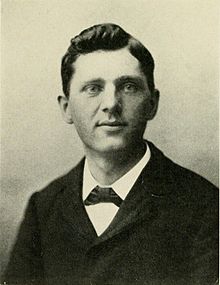
Czolgosz in the 1900s.
He became a recluse. He was impressed after hearing a speech by the political radical Emma Goldman, whom he met for the first time during one of her lectures in Cleveland in May 1901. After the lecture, Czolgosz approached the speakers' platform and asked for reading recommendations. On the afternoon of July 12, 1901, he visited her at the home of Abraham Isaak, publisher of the newspaper Free Society, in Chicago and introduced himself as Fred Nieman (nobody), but Goldman was on her way to the train station. He only had enough time to explain to her about his disappointment in Cleveland's socialists, and for Goldman to introduce him to her anarchist friends who were at the train station. She later wrote a piece in defense of Czolgosz.
In the weeks that followed, his social awkwardness, his evasiveness, and his blunt inquiries about secret societies around Isaak and another anarchist, Emil Schilling, caused the radical Free Society newspaper to issue a warning pertaining to Czolgosz, on September 1, reading:
Czolgosz believed there was a great injustice in American society, an inequality which allowed the wealthy to enrich themselves by exploiting the poor. He concluded that the reason for this was the structure of government itself. Then he learned of a European crime which changed his life: On July 29, 1900, King Umberto I of Italy had been shot dead by anarchist Gaetano Bresci. Bresci told the press that he had decided to take matters into his own hands for the sake of the common man.
New York City police lieutenant Joseph Petrosino believed that the same group had previously targeted President McKinley, but his warnings were ignored.
Assassination of McKinley[]
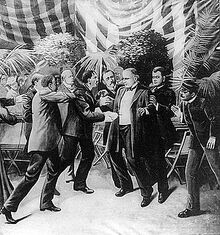
A depiction of the assassination of McKinley.
When given the opportunity to host a public reception for President McKinley, fair organizers chose to site it in the Temple of Music—Louis L. Babcock, grand marshal of the Exposition, regarded the building as ideal for the purpose. The large auditorium was located close to the Esplanade, in the heart of the fair, and had doorways on each of its four sides. In addition to rows of chairs on the floor of the hall, it had spacious galleries. Babcock spent the morning of September 6 making some physical arrangements for the reception. Floor seating was removed to create a broad aisle, running from the east doors through which the public would be admitted, to where McKinley would stand. Once members of the public shook hands with McKinley, they would continue on to exit the building. An American flag was draped behind the President, both to screen him from behind and for decoration—several potted plants were arrayed around his place to create an attractive scene. Besides its utility for other purposes, the ornate building was one of the architectural features of the fair.
Considerable arrangements had been made for the President's security. Exposition police were stationed at the doors; detectives from the Buffalo police guarded the aisle. In addition to McKinley's usual Secret Service agent, George Foster, two other agents had been assigned to the Buffalo trip because of Cortelyou's security concerns. Babcock was made nervous by a joke at lunch in an Exposition restaurant that the President might be shot during the reception. He had arranged for a dozen artillerymen to attend the reception in full-dress uniform, intending to use them as decoration. Instead, he had them stand in the aisle with instructions to close on any suspicious-looking person who might approach the President. These men were not trained in police work and served to crowd the area in front of the President and obstruct the views of the detectives and Secret Service. At such events, Foster usually stood just to the left and behind McKinley. Milburn wished to stand to McKinley's left to be able to introduce anyone he knew in the line to the President, and Foster and another agent instead stood across the aisle from McKinley.
Throughout the afternoon, crowds had filled the floor outside the blocked-off aisle, and the galleries as well, wanting to see the President, even if they could not greet him. McKinley arrived just on time, glanced at the arrangements, and walked over to his place, where he stood with Milburn on his left and Cortelyou on his right. The pipe organ began to play "The Star-Spangled Banner" as McKinley ordered the doors open to admit those who had waited to greet him. The police let them in, and McKinley prepared to perform his "favorite part of the job". An experienced politician, McKinley could shake hands with 50 people per minute, gripping their hands first so as to both guide them past him quickly and prevent his fingers from being squeezed. Cortelyou anxiously watched the time; about halfway through the ten minutes allotted, he sent word to Babcock to have the doors closed when the presidential secretary raised his hand. Seeing Cortelyou looking at his watch, Babcock moved towards the doors. As the reception continued, the organist played works by Johann Sebastian Bach. The procession of citizens shaking hands with their President was interrupted when 12-year-old Myrtle Ledger of Spring Brook, New York, who was accompanied by her mother, asked McKinley for the red carnation he always wore on his lapel. The President gave it to her, then resumed work without his trademark good-luck piece. The Secret Service men looked suspiciously on a tall, swarthy man who appeared restless as he walked towards the President, but breathed a sigh of relief when he shook hands with McKinley without incident and began to move towards the exit. The usual rule that those who approached the President must do so with their hands open and empty was not being enforced, perhaps due to the heat of the day, as several people were using handkerchiefs to wipe their brows; the man who followed the swarthy individual had his right hand wrapped in one, as if injured. Seeing this, McKinley reached for his left hand instead. As the two men's hands touched at 4:07 pm, Czolgosz shot McKinley twice in the abdomen with a .32 Iver Johnson revolver concealed under the handkerchief.
As onlookers gazed in horror, and as McKinley lurched forward a step, Czolgosz prepared to take a third shot. He was prevented from doing so when James Parker, an American of part-African part-Spanish descent from Georgia who had been behind Czolgosz in line, slammed into the assassin, reaching for the gun. A split second after Parker struck Czolgosz, so did Buffalo detective John Geary and one of the artillerymen, Francis O'Brien. Czolgosz disappeared beneath a pile of men, some of whom were punching or hitting him with rifle butts. He was heard to say, "I done my duty." McKinley staggered backward and to the right, but was prevented from falling by Cortelyou, Milburn, and Detective Geary; they guided him across some fallen bunting to a chair. The President tried to convince Cortelyou he was not seriously injured, but blood was visible as he tried to expose his injury. Seeing the pummeling being taken by Czolgosz, McKinley ordered it stopped. Czolgosz was dragged away, but not before being searched by Agent Foster. When Czolgosz kept turning his head to watch the President while being searched, Foster struck him to the ground with one punch.
McKinley had been given nutritive enemas; on September 11, he took some broth by mouth. When it seemed to do him good, the following morning they allowed him toast, coffee, and chicken broth. His subsequent pain was diagnosed as indigestion; he was given purgatives and most doctors left after their evening consultation. In the early morning of September 13, McKinley suffered a collapse. Urgent word to return to Buffalo was sent to Vice President Roosevelt, 12 miles (19 km) from the nearest telegraph or telephone in the Adirondack wilderness; a park ranger was sent to find him. Specialists were summoned; although at first some doctors hoped that McKinley might survive with a weakened heart, by afternoon they knew the case was hopeless. As yet unknown to the doctors, gangrene was growing on the walls of his stomach and toxins were passing into his blood. McKinley drifted in and out of consciousness all day; when awake he was the model patient. By evening, McKinley too knew he was dying, "It is useless, gentlemen. I think we ought to have prayer." His friends and family were admitted, and the First Lady sobbed over him, "I want to go, too. I want to go, too." Her husband replied, "We are all going, we are all going. God's will be done, not ours" and with final strength put an arm around her. He may also have sung part of his favorite hymn, "Nearer, My God, to Thee", although other accounts have her singing it softly to him. Ida McKinley was led away, her place briefly taken by Senator Hanna. Morgan recounts their final encounter, "Sometimes that terrible evening, Mark Hanna had approached the bedside, tears standing in his eyes, his hands and head shaking in disbelief that thirty years of friendship could end thus." When a tentative, formal greeting gained no coherent response, Hanna "cried out over the years of friendship, 'William, William, don't you know me?' "
At 2:15 a.m. on Saturday, September 14, 1901, President McKinley died. At the time of McKinley's death, Roosevelt was on his return journey to Buffalo, racing over the mountain roads by carriage to the nearest railroad station, where a special train was waiting. When he reached that station at dawn, he learned of McKinley's death.
Aftermath[]
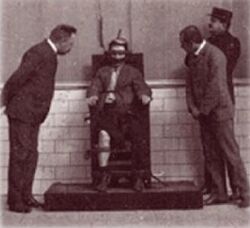
Czolgosz's execution.
Czolgosz was convicted on September 24, 1901, after the jury had deliberated for only an hour. On September 26, the jury unanimously recommended the death penalty. Czolgosz was said to have remained silent and to have shown no emotion upon either his conviction or his sentencing to death. When he was asked by Judge White if he wanted to make any statement in open court, Czolgosz shook his head to indicate that he did not. Upon returning to Auburn Prison, Czolgosz asked the warden if this meant he would be transferred to Sing Sing to be electrocuted, and he seemed surprised to learn that Auburn had its own electric chair.
Czolgosz was electrocuted by three jolts, each of 1800 volts, in Auburn Prison on October 29, 1901, 45 days after Mckinley's death. He was pronounced dead at 07:14, aged 28.
Modus Operandi[]
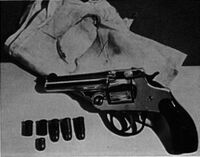
The revolver Czolgosz used, and the burned handkerchief used to conceal it.
Since Czolgosz only killed one person, the term "M.O." is somewhat misused. When he killed William McKinley, he shot him twice with a .32 Iver Johnson revolver he had concealed in a handkerchief.
Known Victims[]
- September 6, 1901: William Mckinley, 58 (25th President of the United States; died two weeks later)
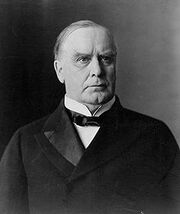
William McKinley
On Criminal Minds[]
- Season One
- "L.D.S.K." - While not directly mentioned in this episode, Czolgosz's mugshot was shown alongside several other famous assassins.
